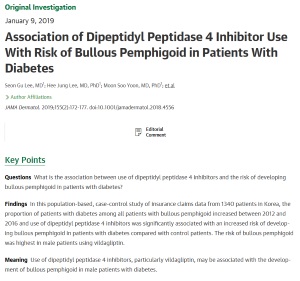Inhibitors of dipeptidyl peptidase 4 (DPP-4), used to treat diabetes, can increase the risk of developing bullous pemphigoid in diabetic patients, a local study revealed. Bullous pemphigoid is a rare skin disease that causes fluid-filled blisters.

According to the study, the number of patients with diabetes and bullous pemphigoid more than doubled from 2012 to 2016. The year 2012 was when local physicians began to use DPP-4 inhibitors in earnest.
Professors at the department of dermatology of CHA University School of Medicine published a paper, “Association of Dipeptidyl Peptidase 4 Inhibitor Use with Risk of Bullous Pemphigoid in Patients with Diabetes,” on the online issue of the JAMA Dermatology on Jan. 9.
In the paper, the researchers said there have recently been some studies that suggested DPP-4 inhibitors’ association with a higher risk of bullous pemphigoid but population-based studies on the association were limited.
The study aimed to characterize the potential association between the use of DPP-4 inhibitors and an increased risk of developing bullous pemphigoid.
The study was retrospective one, based on insurance claims data of patients newly diagnosed with bullous pemphigoid and diabetes from Jan. 1, 2012, to Dec. 31, 2016. The researchers obtained data of control patients with diabetes and without the skin disease randomly, by matching for age, sex, and year of diagnosis within the same period.
The study included 670 patients with diabetes and bullous pemphigoid and 670 control patients. The average of the age was 75.3 years and 51 percent or 342 patients were male in each group.
The result of the data analysis showed that the number of patients with diabetes and bullous pemphigoid more than doubled during the study period from 77 in 2012 to 206 in 2016. The proportion of patients with diabetes among all patients with bullous pemphigoid also went up from 0.18 in 2012 to 0.33 in 2016.
Subgroup analyses also showed a significant association between DDP-4 inhibitors and bullous pemphigoid in males. Among DDP-4 inhibitors, vildagliptin had the highest risk.
The researchers said practitioners should consider the risk of DPP-4 inhibitors, associated with the development of bullous pemphigoid.
However, an endocrinologist expressed a different opinion about the study result on the high risk of vildagliptin in particular.
He said the study had limitations because it was retrospective. It was also questionable whether the prescription pattern of vildagliptin was a corrected result.
“Unlike other DPP-4 inhibitors, vildagliptin is rarely prescribed in primary and secondary medical institutions,” the endocrinologist said. “Considering that bullous pemphigoid is an autoimmune disease, the diagnosis could have been made at large hospitals. This prescription pattern could affect the study result.”
He went on to say that rather than focusing on a particular agent, researchers should find out the cause of the mechanism that DPP-4 inhibitors raise the risk of bullous pemphigoid.
As the prevalence of bullous pemphigoid is low, regulatory institutions could ask each manufacturer of DDP-4 inhibitors for additional data such as randomized controlled trial data to evaluate the risk through a meta-analysis, he added.

